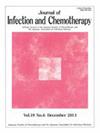大剂量延长输注美罗培南是否有助于治疗儿童中的高耐药性革兰氏阴性菌?
IF 1.9
4区 医学
Q3 INFECTIOUS DISEASES
引用次数: 0
摘要
目的:耐多药感染给临床医生的治疗带来了挑战。这些感染与发病率和死亡率的增加有关。最近,越来越多的文献讨论认为大剂量延长输注美罗培南可能会有所帮助。我们旨在评估大剂量延长输注美罗培南治疗高度耐药革兰氏阴性菌感染的临床疗效:这项回顾性观察研究于 2014 年 12 月至 2020 年 12 月在哈杰泰佩大学伊赫桑-多格拉玛奇儿童医院进行。研究了被诊断为侵袭性多药和极耐药革兰氏阴性菌感染的儿童的临床和微生物学数据。将接受大剂量延长输注美罗培南治疗的患者与接受可乐定或替加环素治疗的患者的结果进行了比较:共有 158 名感染多重耐药和极度耐药革兰氏阴性菌的儿科患者参与研究,其中 76 人接受了大剂量延长输注美罗培南治疗,60 人接受了可乐定治疗,22 人接受了替加环素治疗。治疗结束时,美罗培南组的总体临床应答率为 81.6%,可乐定组为 83.3%,替加环素组为 77.3%(P=0.821)。治疗结束时,美罗培南组的微生物应答率为81.1%,可乐定组为76.4%,替加环素组为72.2%(P=0.694):结论:调整剂量(大剂量和延长剂量)的美罗培南似乎是治疗感染高度耐药革兰氏阴性菌的儿科患者的一种重要而强效的抗生素。在抗菌药物管理过程中,美罗培南还有助于防止使用最新的抗菌药物,如秋水仙碱和替加环素。本文章由计算机程序翻译,如有差异,请以英文原文为准。
Is the high dose extended infusion of meropenem useful in the treatment of highly resistant gram-negative bacteria in children?
Objectives
Multidrug resistant infections present a treatment challenge for clinicians. These infections have been associated with increased morbidity and mortality. Recently, there has been increasing discussion in the literature that high dose extended infusion of meropenem may be helpful. We aimed to evaluate the clinical efficacy of high dose extended infusion of meropenem in the treatment of highly resistant Gram-negative infections.
Methods
This retrospective observational study was conducted between December 2014 and December 2020 at Hacettepe University Ihsan Dogramaci Children's Hospital. Clinical and microbiological data of children diagnosed with invasive multidrug and extremely drug resistant Gram-negative infections were studied. The findings of patients given high dose extended infusion of meropenem were compared with patients who received colistin or tigecycline.
Results
Overall, 158 pediatric patients infected with multidrug and extremely drug resistant gram-negatives were enrolled; 76 treated with high-dose prolonged infusion of meropenem; 60 treated with colistin and 22 with tigecycline. The overall clinical response at the end of the treatment was 81.6 % in meropenem group, 83.3 % in colistin group and 77.3 % in tigecycline group (P = 0.821). Microbiological response at the end of the treatment was 81.1 % in meropenem group, 76.4 % in colistin group and 72.2 % in tigecycline group (P = 0.694).
Conclusion
Meropenem, with an adjusted dose (high-dose and extended), seems a crucial and robust fighting agent in the treatment of pediatric patients infected with highly-resistant Gram-negative bacteria. It may also be useful in preventing the use of the latest fighting tools such as colistin and tigecycline during the antibacterial stewardship process.
求助全文
通过发布文献求助,成功后即可免费获取论文全文。
去求助
来源期刊

Journal of Infection and Chemotherapy
INFECTIOUS DISEASES-PHARMACOLOGY & PHARMACY
CiteScore
4.10
自引率
4.50%
发文量
303
审稿时长
47 days
期刊介绍:
The Journal of Infection and Chemotherapy (JIC) — official journal of the Japanese Society of Chemotherapy and The Japanese Association for Infectious Diseases — welcomes original papers, laboratory or clinical, as well as case reports, notes, committee reports, surveillance and guidelines from all parts of the world on all aspects of chemotherapy, covering the pathogenesis, diagnosis, treatment, and control of infection, including treatment with anticancer drugs. Experimental studies on animal models and pharmacokinetics, and reports on epidemiology and clinical trials are particularly welcome.
 求助内容:
求助内容: 应助结果提醒方式:
应助结果提醒方式:


